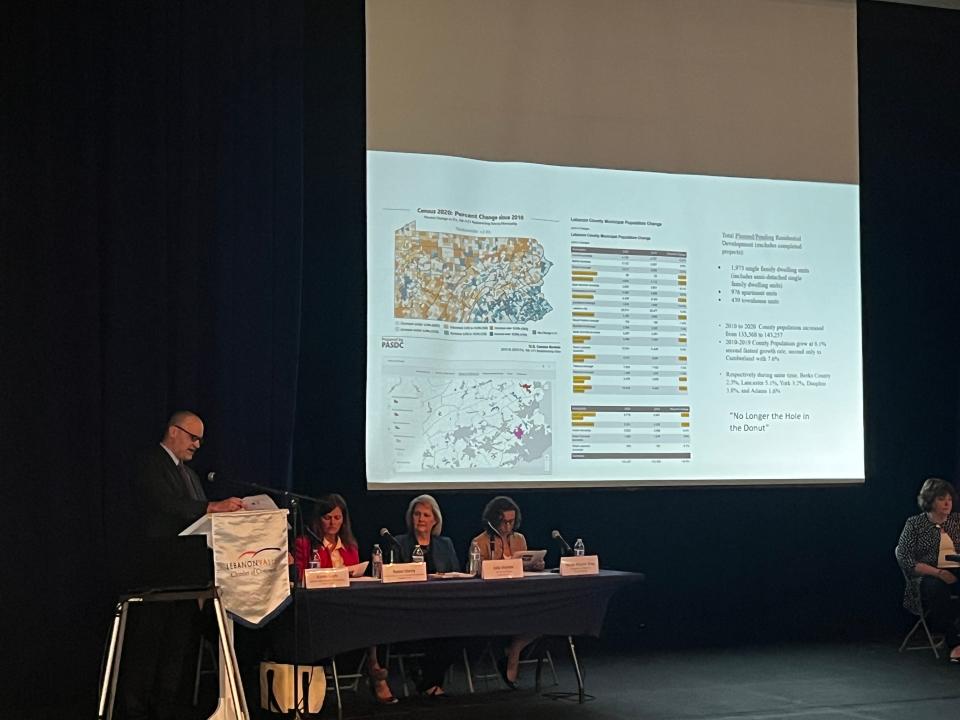Lebanon County by the numbers: It's growing, jobs are plentiful, but health is an issue
Business and community leaders as well as elected officials met the morning of Thursday, May 25, in the Leedy Auditorium at Lebanon Valley College for the first ever State of the County address hosted by the Lebanon Valley Chamber of Commerce.
A panel of seven spoke alongside chamber president Karen Groh, providing insight into where the county currently stands and its future needs.
The panel covered the topics of business and economic growth, education, tourism, community health, transportation, emergency preparedness and county financial health.
Much of the information shared in the presentations, including the presentation slides, are now available online at lvchamber.org/stateofthecounty.
Here are some key takeaways from the event:
Business and economic growth

The largest industries in Lebanon County include manufacturing, transportation and warehousing, which are both roughly double the national average in terms of industry jobs.
Professional, scientific and technical services as well as finance and insurance are far below the national average. The former is, however, among the industries in the county with the most growth.
Transportation and warehousing is the fastest-growing industry in the county, with a net increase in the number of jobs of 46% over the last decade.
The top three industry sectors with the highest average earning are management of companies and enterprises, utilities and government. Manufacturing, construction and transportation and warehousing all fall within the middle range of incomes, ranging from $65,000 (transportation and warehousing) to $78,000 (manufacturing).
Prior to the year 2000, the county had 89 warehouses using 455 acres of land, with a total of 4.2 million-square-feet under roof, according to president of Lebanon Valley Economic Development Corporation Susan Eberly. Currently, the county has an inventory of 22 million-square-feet under roof utilizing 2,150 acres of land.
Eberly described the growth as "on steroids."
Lebanon growth: Here's which Lebanon County municipality grew the most between 2020 and 2022
About 66% of businesses in Lebanon County employ 1-9 people, 98.7% of businesses in the county are considered small businesses, defined as having less than 100 employees.
The number of jobs continue to outpace available workforce, Groh said. Even if everyone in the county currently enrolled in unemployment were employed, the county would still have job openings.
Groh said that access to affordable child care, transportation, language barriers and lack of skills are all barriers to employment in the county.
Jobs requiring no formal education, jobs requiring a high school diploma and jobs requiring a bachelors degree all outpace the county's population of people at those education levels. Jobs requiring some college or non-degree awards, associates degree and graduate degree or higher are all under the number of people with those jobs.
Education
The county currently has 19,864 students enrolled throughout its districts, which employ a total of 1,431 professional staff.
The post-graduation plan for the class of 2022 break down to 60% of students attending a 2- or 4-year higher education program, 35% entering the workforce and 5% enlisting in the military.
About 50% of students who attend the Lebanon County Career and Technology Center enter the workforce after graduation, 40% continue education and 10% enlist in the military.
The average student enrollment at the CTC, home to 22 programs as part of seven career pathways, is 566 over the last five years. The project enrollment for the 2023-24 school year is 747.
Julia Vincente ELCO superintendent and CTC superintendent of record said that 150 students have been waitlisted and are unable to join the program next year.
"This is a crucially important and urgent concern that has caught the attention of many," she said, "and I'm pleased to share with you that conversations are in process to address this."
Community health needs
The Community Health Council's public health priorities right now are lifelong wellness, the social determinants of health, and mental well being.
Smoking, diabetes, obesity, physical inactivity and high blood pressure cost U.S. employers $36.4 billion per year in employees missing days of work.
The cost of preventing illness and injury far outweigh the cost of paying to treat them.
In Lebanon County, 68% of the population is considered overweight, 35% have high cholesterol, 33% have high blood pressure, 19% are smokers and 10% have diabetes. About 35% of adults reported no exercise in the last month and only 4% consume recommended servings of vegetables, according to the 2022 WellSpan Health community health needs assessment.
Nicole Maurer Gray, executive director of the Community Health Council, said that rates of diabetes are up 61% since 2004.
Chronic disease isn't alone attributed to individual behavior, but social conditions such as housing and food security as well.
Pollution: The 'Dirty Dozen' of greenhouse gas polluters: See which Central PA sites made the list
About 8% of the county's population is living under the federal poverty line and 28%, 19,470 people, are living below the ALICE threshold.
About 45% of renters and 19% of homeowners spend more than 30% of their income on housing, and are considered cost burdened.
Gray provided a preview of the Lebanon County Housing Study, which is planned for release sometime this summer. According to that report, multifamily rental occupancy rates are at 100% in Annville-Cleona, Eastern Lebanon, North Lebanon and Palmyra.
Gray said that virtually every indicator measured for mental health is getting worse.
Much like social determinants, mental health contributes to chronic illness and can affect the economy as even moderate health conditions are estimated to cause 150 hours of lost productivity per year. Depression alone causes an estimated 200 million lost work days.
One in five Americans have a mental health condition, and according to the 2022 WellSpan Health CHNA, 67% of adults report having one or more days with depressive symptoms over a two week period.
According to the 2022 PA Youth Survey, 39.5% of youth reported being depressed or sad most days and 18.9% reported having considered suicide, up nearly 4% since 2015.
Tourism
According to Jennifer Kuzo, president of Visit Lebanon Valley, tourism in the area is on the upswing, and the contributing industry surrounding tourism has bounced back since the pandemic.
Kuzo said the large drivers of tourism have been the various trails, parks and outdoor recreation, as well as the many sporting events hosted by In the Net and Spooky Nook. The Expo Center, which hosts roughly 200 events throughout the year, has been one of the largest drivers of tourism, especially for first-time visitors.
The Java Journey and Libations Trail, two events hosted by Visit Lebanon Valley, have promoted and drove traffic to local dining businesses.
In the last five years, the county has seen a 192% hotel tax revenue growth, and $258.8 million were spent in the industries contributing to tourism in 2021.
Kuzo expressed the importance of preserving the scenic farmland in the area as a way of nurturing the tourism industry.
Transportation

Jonathan Fitzkee of the Lebanon County Planning Department described the growth of the county over the last 10 years, seeing a population growth of 6.1% between 2010 and 2019.
He also provided a total number of planned/pending residential developments in the county, which includes 1,973 single-family units, 976 apartment units and 439 townhouse units.
That growth requires changes and maintenance to the county's roads.
The planning department's primary focuses are on safety, operations and maintenance. They use their Transportation Improvement Plan, Long Range Transportation Plan, and Unified Planning Work Program to inform their decision making.
Emergency preparedness
Bob Dowd, director of the Department Emergency Services, listed a number of potential hazards that could face the county, including extreme temperatures, winter weather events, wildfires, civil unrest and train accidents, among others.
"We stand prepared for any type of incident regardless of severity or time of day, be it a severe weather event, an industrial accident, an emergency or civil unrest, our team is train and equipped to handle the situation."
He said that it's crucial for businesses to be aware of the kinds of hazards that their area could face, and even more important to have a plan in place, exercised regularly and updated at least once per year.
Dowd said that the department would be happy to help any business in creating a plan. Lebanon County Department of Emergency Services can be contacted at (717)272-7621, or through email at em@lcdes.org.
County Overview
Jamie Wolgemuth, chief clerk and administrator for Lebanon County government, said that the county is quickly approaching its transition from a fifth class county to a fourth class county.
Since 1970, population has grown by 10,000 people every decade.
At over 143,000 people, Lebanon County is the largest fifth class county in the state.
At a population of 145,000, the county will move into a fourth class designation.
That growth is reflected in its increase in the value of property, which is now slightly higher than Dauphin on average.
Despite those increased property values, the median county tax levy on property remains in the middle for the region at about $787 per year, lower than half of other fifth class counties.
Lebanon County is now rated as an A+ stable from Standard and Poors, up from a triple B rating 10 years ago. Wolgemuth said that rating was brought up by having structurally balanced budgets, adequate reserves, a funded pension and manageable debt.
Daniel Larlham Jr. is a reporter for the Lebanon Daily News. Reach him at DLarlham@LDNews.com or on Twitter @djlarlham
This article originally appeared on Lebanon Daily News: Business, education, health and all else; Lebanon County in numbers

